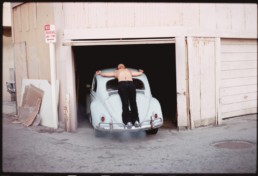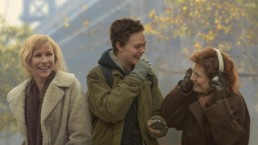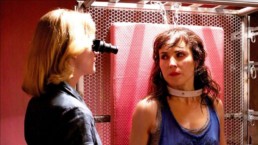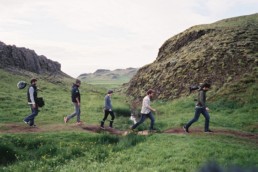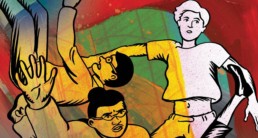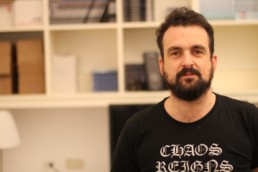'Last Men in Aleppo' Review: Hope in the Darkest of Times
One of the heaviest films to come out of Sundance earlier this year was the documentary Last Men in Aleppo.
Like its title suggests, the film centers around a group of Syrian men who left normal, civilian jobs to form an unofficial emergency response unit known in the community as the White Helmets. The men risk their lives every day by staring death in the face, whether it be scouting the Russian bomb-dropping planes or attempting to rescue their injured neighbors on the ground. The Grand Jury Prize: World Cinema Documentary winner is coming to select theaters this Friday, and while it should be considered essential viewing, it is definitely an emotionally challenging film.
Leaving their families and what little security they have behind to work a job that puts their lives in constant jeopardy, the White Helmets are the epitome of selfless heroes. The Syrian civil war has been an increasingly relentless bloodbath for the people of Aleppo, and director Feras Fayyad does not shy away from showing the heartbreaking casualties. Right off the bat, we are shown rescue footage of children trapped in the rubble, dead babies, and other images that are sure to leave a lasting impression. We are thrust onto the front lines alongside Khaled, Mahmoud, Subhi, and other volunteers as they navigate through the chaos and confusion.
But this isn't just a shock and awe documentary, nor does it rely on its graphic nature to attract attention. The heart of the film and the reason why it is one of the most compelling documentaries of 2017 thus far lies in the story of a group of men who sacrifice everything for their community, while the prospect of peace remains a distant and unattainable facade. Some, we come to find out, sacrifice their lives for the cause. Others question why no one has come to support their efforts and wonder if anyone, other Arabs and the West alike, even care.
The uprising of the Syrian civil war has been a relentless bloodbath for the people of Aleppo, and director Feras Fayyad does not shy away from showing the heartbreaking casualties of this war.
Director Feras Fayyad shoots Last Men in Aleppo in a style that exuberates naturalness in the most unnatural of situations. This cinema vérité style is unfiltered and raw but it is the only way a story like this should be told.
Sprinkled in between the moments of despair are moments of hope. In one scene, a White Helmet comes face to face with a young boy he rescued just days earlier. The boy, who could not have been more than six years old, had massive head trauma and intense bleeding when he was pulled out from under the rubble of his own home. The reunion is a bittersweet one for the volunteer– one moment he praises God for the boy's health and the next, he is reminded of those he could not save and falls into a somber mood.
Last Men in Aleppo holds a great deal of cinematic importance for its timeliness and historical context. The closing frames of the film reveal that even today, millions are still under siege in Syria and live in daily fear over the anticipation of waiting for the next bomb to drop. If this film does nothing else, It serves as an eye-opening experience to those who are unfamiliar with the crisis abroad and you will not leave without putting faces to the statistics we hear about on the news.
'Last Men in Aleppo' is not rated. 110 minutes. Opening this Friday at the Laemmle Music Hall.
'Burden' Review: Chris Burden, Self-Tortured Artist
Chris Burden was constantly asking, "What can art be?" "If art was violent, painful, or scared the shit out of you, is that art?"
If you've been to the Los Angeles County Museum of Art, or the LACMA, on Miracle Mile, you've seen the exhibition "Urban Lights"– a cluster of lamp posts just outside of the museum's entrance. This installation, which consists of 202 authentic street lamps from the 1920s and 1930s, has been a tourist attraction and talking point since its creation in 2008, some even calling it the symbol of Los Angeles. The documentary Burden explores the unconventional life of the "Urban Lights" creator Chris Burden, a former resident of Topanga Canyon and world-renowned performance artist whose career was made from controversy and shock value.
In this compelling portrait, filmmakers Richard Dewey and Timothy Marrinan delve deep into the artist's past for a glimpse into the eclectic and eccentric life of Chris Burden. From his early days as an art student at UC Irvine, Burden was an unconventional guy. One assignment he called "5-Day Locker Piece" consisted of him caged in a 2' x 2' x 2' university locker for 5 days. His peers thought he was crazy, but brilliant. His professors called him “A walking slap in the face.” And while his performances may have raised eyebrows both in and out of the art world, there was no denying that Chris Burden was a pioneer.
He may have compared himself to Da Vinci, Michelangelo, Van Gogh, and other great artists of all time, but unlike the spectator approach we take in viewing those great works, Burden's talent forced the viewer to be physically active in the experience. He gravitated toward avant-garde sculpture work, living on the edge of sadomasochism and coming close to death many times for the sake of his piece. He did it all, from being shot in the arm to nailing his palms to the back of a running car for hours (which David Bowie alludes to in his song 'Joe the Lion' off his 1977 album 'Heroes'), Burden was known for eliciting the energy in everyone around him.
His wild personality attracted attention, but it was his true talent that made him an artist.
Burden is able to share many stories from the artist's past through interviews with Chris himself and those who knew him well. Roger Ebert called him a "strange kind of importance" in a profile piece he wrote for the Chicago Sun-Times. His wife talked about her anxiety when Chris would self-harm in the name of art. In one art piece, titled "The Confession," Chris confessed to an extramarital affair, a fact his wife was totally unaware of, prior to watching his performance. The anecdotes relived by those who knew him, including past teachers, classmates, and fellow performance artist Marina Abramovic, are entertaining, cringe-worthy, and darkly humorous.
Chris Burden was constantly asking, "What can art be?" "If art was violent, painful, or scared the shit out of you, is that art?" He set out to answer those questions through his various projects and crossed the boundaries of “appropriate” too many times to count, but in doing so, he made a name for himself. Chris hated the comparison of him to the stuntman, Evel Knievel, a man he called "a trickster," while he proudly considered himself as "real." I have to admit that, after watching "Burden," I would have to agree that Chris Burden was indeed the real deal.
Unfortunately, Chris died from cancer in 2015 at the age of 69 and just days shy of the unveiling of his last completed installation, "Ode to Santos Dumont." His wild personality attracted attention, but it was his true talent that made him an artist. He left a legacy through his contribution of the LACMA's "Urban Lights," which is photographed almost as much as the Hollywood sign, but his true gift to the community has been his individuality and reminder to other artists to just be themselves.
'Burden' is not rated. 88 minutes. Opening at the Nuart Theater this Friday and now available on demand, iTunes and Amazon Video.
'3 Generations' Review: Not the Trans Youth Film We Were Hoping For
3 Generations may not be the movie its filmmakers and audiences were hoping for, but if there is any takeaway to be had, it is the optimism that one can get through unbelievable hardships with family by their side.
It is obvious that 3 Generations is a film The Weinstein Company was determined to make, no matter what. Originally set for a 2015 release, the Gaby Dellal-directed drama faced criticism from the get-go. Campaigning to bring it's originally slotted "R" rating down to "PG-13," this family drama, which centers on a transgender teen's attempt gain support from his unconventional family about his decision to start testosterone hormones, was going to let nothing get in the distributor's way– not technical errors, continuity errors, or errors of any kind. And while the seed of a story is there, sloppy edits, plenty of plot holes, and distracting voiceovers resembling a Japanese game show, turn a story that would have been a sensitive coming of age film into a comedy of errors.
Our protagonist, Ray (Elle Fanning), has identified as a male since childhood and has reached the stage in his transition process to start taking testosterone. After visiting a doctor in a well-to-do New York City borough, Ray's mother Maggie (Naomi Watts) and his lesbian grandmother Dolly (Susan Sarandon) aren't shy about voicing their concerns. While Dolly isn't convinced this is the appropriate next step given Ray's age, Maggie dreads the fact that she will need to make contact with her estranged ex-boyfriend and Ray's father, Craig (Tate Donovan), to secure parental consent. Family drama aside, Ray isn't deterred from living his truth and makes it abundantly clear that he is willing to do whatever it takes to begin "T."
Since it's scheduled release in 2015, transgender issues in film have become more widely seen and accepted, thanks to TV shows like "Transparent" and the Oscar-nominated film, The Danish Girl. While 3 Generations had the potential to be another strong entry in the diversity pool, it ends up being cliché, shallow, and a poor attempt at revealing the struggles of trans youth to mainstream audiences. It just didn't seem like director Gaby Dellal understood the magnitude of the extremely personal content she was working with or had spent enough time digging deeper than headline news stories about trans youth.
This is not to say Elle Fanning's performance was off-putting, in fact, she took a huge risk in accepting this role, but as famously accomplished as she is, she can't tap into what it's like to struggle in gender purgatory.
Personally, I think the film should have kept its working title About Ray. The title 3 Generations seems to downplay the importance of Ray's situation by comparing his mother's and grandmother's non-existent life crises. Perhaps, this change was made after Dellal re-edited the film in 2016, when it had been shelved for nearly a year. I'm also curious if the original film was as poorly dubbed as the final edit I saw last week, when I counted at least five times that a character's spoken lines did not visually match the words coming out of their mouth. A terribly distracting and unintentionally comical situation of voice-overs gone wrong.
Technical flaws aside, the biggest disservice of 3 Generations is the missed opportunity to have an actual transgender actor play the part of Ray, or at the very least a more anonymous actor. This is not to say Elle Fanning's performance was off-putting, in fact, she took a huge risk in accepting this role, but as famously accomplished as she is, she can't tap into what it's like to struggle in gender purgatory. Her performance is explosive when it needs to be and introspective in all the right moments, yet it is still hard to get lost in her struggles when the distraction of her Julia Roberts a lá Mother's Day wig steals every scene.
3 Generations may not be the movie its filmmakers and audiences were hoping for, but if there is any takeaway to be had, it is the optimism that one can acquire through surviving unbelievable hardships with family by their side. For as uninspired as the film was, at the core of the story is a silver lining in the message that individuality should be celebrated and unconventional is beautiful, and that is definitely a message worth spreading.
'3 Generations' is rated PG-13 for mature thematic content, some sexual references, and language. 92 minutes. Opening this Friday at ArcLight Hollywood and the Laemmle Playhouse 7 in Pasadena.
'Rupture' Review: An Alien Sci-Fi with More Questions Than Answers
Rupture forces innocent victims to confront their worst fear and, ironically, that includes the film's director.
Director Steven Shainberg has made a name for himself in the alt/indie film world by pushing audiences toward the outer edges of their comfort zone. In his 2002 breakthrough film Secretary, a disturbed young woman gets a job as a legal secretary when her relationship with the lawyer she supports quickly turns not only sexual but sadomasochistic, reminiscent of 50 Shades of Grey. In his latest film which comes 11 years since his last project (Fur), Shainberg stays true to his reputation for incorporating torture with sexual undertones in the sci-fi picture, Rupture.
The film stars Noomi Rapace as Renee Morgan, a single mom who is deathly afraid of spiders, yet jumps at the opportunity to go skydiving with one of her friends. After dropping her son Ethen (Percy Hynes White) off at her estranged husband's house, she is on her way to meet a friend when her car tire suddenly goes flat. Accepting help from a man who (no coincidence) happened to be driving right behind her, and pulls over to inspect her car, Renee is suddenly tackled, tasered, and kidnapped– but why?
Turns out, a group of mysterious people has been spying on Renee for "a long time" by using household technology like home security cameras. Renee is chained to a portable examining table in a nondescript dungeon basement, sweating profusely as she struggles to break free from these people who are wearing what can only be described as Burning Man sunglasses. "Who are these fucking people?" she screams. It is then that she hears another prisoner, also in chains, answer her with "G1012X."
When her captors turn into shape-shifting alien creatures reminiscent of “Sloth” from "The Goonies," it's really hard to emotionally sympathize with her situation.
What is G1012X? Exactly. It is here where Rupture turns from storybook thriller to questionable sci-fi and that's all because of its ambiguity. We are questioning why Renee's captors rub their faces against hers and subject her to her biggest fear (that spider comes full circle) up until the end of the film, but by that point, it is hard to take the severity of the situation seriously. When her captors turn into shape-shifting alien creatures reminiscent of “Sloth” from The Goonies, it's really hard to emotionally sympathize with her situation.
There are, however, interesting elements to Rupture that seem to be overshadowed by the overall lack of convincing execution, but it isn't all dismissive. The wallpaper, reminiscent of The Shining carpet pattern, is a creepy yet welcomed touch. The torture of one prisoner is very A Clockwork Orange and definitely nails the sadistic horror mood. While these moments may have had me momentarily question my criticism of the film, it was then validated with Rupture's frustratingly open-ended ending. All this to say, my final takeaway is that, although Steven Shainberg’s past work has been good, Rupture will likely not be added to that list.
'Rupture' is not rated. 102 minutes. Opening tomorrow at the Arena Cinelounge Sunset.
'Tomorrow' Review: Mélanie Laurent Documentary Inspires Eco-Conscious Change
Divided into five chapters, Tomorrow looks at different countries and cities to explore how the local communities are living green and working together towards a happy and healthy lifestyle for all.
Tomorrow, April 22, 2017, the "March for Science" will take place in Washington, D.C. and over 500 cities across the world to bring government attention to the importance and impact of science research on the future of our global civilization (a cause that some in positions of power are planning to de-fund). It is an opportunity to have collective voices heard and to hopefully inspire others to make a difference. With a similar agenda, and just in time for Earth Day, comes an eye-opening eco-documentary from French actress Mélanie Laurent (Inglorious Basterds) and French activist, author, and filmmaker Cyril Dion, also appropriately called Tomorrow (Demain).
Tomorrow begins with shocking statistics about how the demise of the human race is due to three contributing factors: climate change, the destruction of the earth's surface, and population growth. It is nothing we haven't all heard before, but instead of just reciting facts and taking a doom and gloom perspective, this documentary gives insight into how we can make a difference locally, in our towns, on our streets and backyards.
Divided into five chapters, Tomorrow looks at different countries and cities to explore how the local communities are living green and working together towards a happy and healthy lifestyle for all (and I'm assuming the filmmakers even planned their flights accordingly so as to not use too much fuel for their various travels).
Chapter One focuses on agriculture, mainly urban farming in Detroit. The main takeaway here is that cutting down on meat consumption, even if only one less day a week, will have a huge impact on reducing our carbon footprint and saving resources like fossil fuels and fresh water. Chapter Two is all about energy, the goal here is to eventually have all energy be produced by the sun, wind, or water and not carbon, coal, or oil (plus- geothermal heat is free!). We travel to the energy-conscious city of Copenhagen, where 21% of people get around on foot, 26% use bikes, and 20% use mass transit. That means 67% of people don't drive. As a Los Angeles-native, this is one of the most mind-blowing facts to comprehend.
The silver lining that 'Tomorrow' emphasizes is that it is not too late, but only if we act now.
Chapter Three focuses on the economy and the necessity for an ecosystem of currency, not just one universal standard. We visit Switzerland to get a better understanding of their two-currency system, which claims to be more resilient than just a single method of payment. Chapter Four talks about democracy and we look to India for a better understanding of how a proactive local government is giving a new meaning to the word "democracy." Chapter Five is all about education. We look to Finland to gain a better understanding of their inspiring school system, which educators say is due to the trust in their child-centered teaching methods, no national testing and having teachers undergo lessons in child psychology before running a classroom. It is typical for a classroom in Finland to have two teachers per fifteen students, a stark difference to the underfunded and overcrowded classrooms in America.
It's a scary thought to know that at this rate, catastrophic changes can happen by the end of the century. The silver lining that Tomorrow emphasizes is that it is not too late, but only if we act now. The consequences of our actions have been overlooked because these effects don’t happen overnight but take time to develop. Unfortunately, we're feeling the heat (pun intended) and this is the critical time for humanity to understand that how we have treated our planet is catching up with us; Fortunately, we can still do something about it. We only get one world, let's do our best to take care of it, starting today.
'Tomorrow' is not rated. 118 minutes. Now playing at the Laemmle Music Hall.
'Somewhere Beautiful' Review: Heartbreak Prevails in This Lovely Indie
It can be gathered by the end of the film that somewhere beautiful isn't nirvana where heartache is left behind, rather a harsh reminder of the normality that sometimes relationships drift apart and people move on, no matter how beautiful the dream of togetherness may seem.
After first hitting the festival circuit in 2013, Armenian-American director Albert Kodagoliabeen's debut feature film, Somewhere Beautiful, has finally secured a theatrical release date. Opening at the Los Feliz 3 this Friday, the film may have been sitting on the shelf for close to four years, but its return to the screen remains as relevant and radiant as ever.
Shot on both 16mm and 35mm film in the Patagonian wilds of Argentina and sun-drenched Los Angeles, Somewhere Beautiful is a story about heartbreak and a look at two relationships in varying states of dissolve. Aside from directing, Kodagoliabeen also stars in the film as Albert, a director who returns home to Los Angeles after a shoot to find that his wife Rachel (Robyn Buck) has left both him, and their toddler, due to his ongoing emotional/physical unavailability. Yet Rachel continues to leave him voicemails which play as voiceovers as he struggles to get his life back on track.
Simultaneously, in the wild landscape of Argentina, a photographer (Anthony Bonaventura) begins to notice the budding relationship between his wife Elena (María Alche) and their tour guide (Pablo Cedrón). Elena finds herself in the middle of the two men, quite literally, as she acts as a translator for her husband. The interest in this forbidden love interest manifests as a slow build that comes to a devastating end captured in one of the most beautiful places in the world.
For as beautiful as the film is aesthetically, it is further boosted by the soothing and transformative music of Avi Buffalo and Andrea Silva, appearing on the soundtrack.
For as beautiful as the film is aesthetical, it is further boosted by the soothing and transformative music of Avi Buffalo and Andrea Silva, appearing on the soundtrack. Avi's breezy, California-cool melody, mixed with the lively and alternative sounds of Andrea's Colombian roots, give the film a warm, organic feeling. If only the same could be said about the dialogue where, in several scenes, the characters recite lines in a very rigid way, suggesting that it may have been rehearsed too many times. Aside from some awkward moments, the lines themselves are subtle poetry– even the simple line "Go forward, my friend" is one that has resonated with me in the most bittersweet way.
'Somewhere Beautiful' is not rated. 78 minutes. Opening on Friday at the Los Feliz 3.
'My Entire High School Sinking into the Sea' Review: High-Concept Art
A true form of video art that may look childlike and innocent on the outside, but reveals within the script, the deeper conversations about the abuse of power, patriarchy, and the hero's journey.
Comic book writer and cartoonist Dash Shaw creates a high concept and forward-thinking animated film with My Entire High School Sinking into the Sea. Joining the GKids label alongside other Studio Ghibli movies, this feature is one part ticking-time-bomb adventure, one part high school comedy throwback, and all parts energizing fun. Aside from its creative storytelling, Jason Schwartzman, Lena Dunham, Reggie Watts, Maya Rudolph, and Susan Sarandon all lend their recognizable voices to the project, making this a film to remember.
It begins on the first day of sophomore year for best friends Dash (Schwartzman) and Assaf (Watts), who are aspiring journalists. Along with their editor Verti (Rudolph), they are determined to have their writing taken seriously. Even their latest publication, "Survival Tips for Freshman", struggles in distribution, despite it being free. Their status isn't helped by the understanding that they definitely aren't the coolest kids in school, evident by the fact that popular, student council president-seeking, Mary (Dunham), obviously can't stand Dash.
But as Dash tries to prove that print isn't dead by creating lies about the size of Assaf's genitalia in order to sell more newspapers, as well as disrupt the burgeoning romantic relationship between Assaf and Verti, he accidentally discovers that the biggest story is right under his nose. He literally uncovers a secret about the school's building code, including that the plans for the highly anticipated auditorium, have been forged by the principal. The code further reveals that the integrity of the entire school building is vulnerable (it sits on the edge of a cliff) and could collapse any minute. With this knowledge, Dash assembles his team of friends, Assaf and Verti, as well as acquaintances who turn into friends, Mary and the lunch lady Lorraine (Sarandon), to band together to save the school.
Just because 'My Entire High School Sinking into the Sea' is an animated film, it is not immune from death scenes, in fact, there is a fair share of gruesome decapitations so consider yourself warned.
The mixed media animation style in My Entire High School Sinking into the Sea is so eye-catching, it's hard to look away (not that you'd want to, given that this movie perfectly executes what it sets out to do). Incorporating drawings, paintings, and collage, this is a true form of video art that may look childlike and innocent on the outside, but reveals within the script, the deeper conversations about the abuse of power, patriarchy, and the hero's journey. Just because "My Entire High School Sinking into the Sea" is an animated film, it is not immune from death scenes, in fact, there is a fair share of gruesome decapitations so consider yourself warned.
My Entire High School Sinking into the Sea is good for so many reasons, namely the unique video art and talented cast are the obvious ones, but what really resonated with me was the number of poignant moments happening at the most unexpected times. At the end of the day, this is a feel-good movie that leaves you nostalgic for the past and appreciative of the value of friendships.
'My Entire High School Sinking into the Sea' is rated PG-13 for some images of peril, sexual references, and drug material. 75 minutes. Opening at the Nuart Theatre this Friday.
Nacho Vigalondo talks Stunt Doubles and Spook Houses in 'Colossal'
When I meet director Nacho Vigalongo, I'm immediately drawn to his Van Halen-spoof "Von Trier" t-shirt. We sit down on the couch and jump into talking about his latest indie film, "Colossal." Starring Anne Hathaway (who was pregnant at the time, more on that later) and Jason Sudeikis, the film is an unexpected blend of modern rom-com and kaiju. In our exclusive interview, we talk about his favorite job (which involved dressing up as Norman Bates), his shared interest with Rob Zombie, and a scene that used a stunt double in the cleverest of ways.
If someone walks into "Colossal" expecting a typical monster movie, are you happy to toy with their expectations?
I'm happy and terrified at the same time. The reason why someone likes the film- the unexpected element- is the same reason why someone else will hate it. When you make a movie that doesn't make people feel at home, out of their comfort zone, it's a reason for people to feel [offended] by the film. When I was making this movie, I was in a total Dr. Jekyl and Mr. Hyde complex, like shooting a joke that happens right after a really dark moment. I like playing those contrasts, even if it's going to make people get angry. But, the other side of my brain wants me to make a movie for everybody, something everyone will enjoy. I have these feelings all the time. But, for good or bad, Mr. Hyde tends to win.
You also wrote the film, what was that process like?
In the beginning of the process, you have to feel like a child. You have to wonder, "Wouldn't it be cool if this happened?" In writing "Colossal," my first thought was how I could make a monster movie without having a budget. I'm just a guy from Spain writing from his little flat in Madrid, trying to find a way to make a monster movie. I always recommend keeping a level of innocence at the beginning of the writing process.
I'm just a guy from Spain writing from his little flat in Madrid, trying to find a way to make a monster movie.
What was your first job outside of filmmaking?
Hmm, I can't remember my first job but the best job I had in my life was during college, the summer after my second year. I was working as Norman Bates in a [haunted] house. I was paid to scare people. I had a broom and had to pretend to hit people with it. There is no better job than scaring people.. filmmaking isn't that different. That's the kind of purity I want in my movies.
Did that job influence your interest in film, or directing?
I don't think it directly influenced me, but it was in the key of what I wanted to do in life. One of my dreams in life is to own a spook house and a witch train. One of the American filmmakers I admire the most is Rob Zombie. I love his style! The fact that he hosts these haunted houses every Halloween makes me admire the guy even more.
One of my dreams in life is to own a spook house and a witch train.
Now I may be reading into this too much, but in the movie, the monster pops up in Seoul, South Korea. I thought it was interesting it took place there because Anne Hathaway's character was battling her own demons in her "soul." Am I on to something?
You know what, I'm not going to contradict that. I don't think the filmmaker should be the keyholder to the meaning of the film. That's my way to avoid answering your question, haha.
Fair enough! I understand that Anne was in her second trimester of pregnancy during the shoot. How difficult was for you as the director?
I was very delicate in the way we made the shot list, especially when dealing with a lot of fights. We would place the camera a certain way and used a stunt double. You remember the scene where she is doing the human burrito (rolling up in the air mattress)? There are two actresses on screen- Anne Hathway faces the camera and then the stunt double is doing the roll and the unroll.
Wow, I had no idea. I bet it was torture for her to pretend to drink too.
Haha oh yeah!


